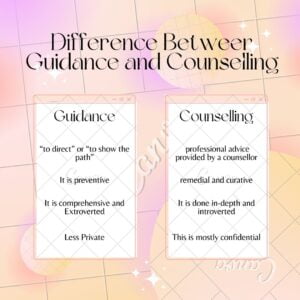Counselling is a one-to-one interaction between two people wherein one person endeavours to help the other. It is individualized and personalized assistance related to personal, educational, vocational health etc. other aspects of life in which all pertinent facts are studied and analysed and a solution is sought, often with the assistance of a specialist, however, the counselled is taught to make his own decision. The person who takes the counselling is known as counselled and the specialist is called the counsellor.
Definition of Counselling
- Stefflre and Grant (1972) “Counselling denotes a professional relationship between a counsellor and a client. This relationship is mostly face to face, although it may sometimes involve more than two people, and is specifically designed to help the client understand and clarify his views of his life situation so that he can make a meaningful and informed decision”
- Blackham (1977) defines “Counselling as a unique helping relationship in which client is provided the opportunity to learn, feel, think, experience and change in ways that he or she thinks is desirable.
- The British Association for Counselling defines it as “the skilled and principled use of a relationship to facilitate self-knowledge, emotional acceptance and growth, and the optimal development of personal resources. The overall aim is to provide an opportunity to work towards living more satisfyingly and resourceful”
Guidance and counselling are mutually related processes but are not the same. Guidance is a more comprehensive process that may/may not include counselling. Counselling as a process is a specialized and most important service in the whole guidance program.
Principles of counselling
Counselling is a professional service with a well-defined process and based on certain principles. These principles work as guidelines while helping the client. The main principles of counselling are as follows-
- Principle of acceptance: Accept and regard the client concerning his physical, psychological, social, economic and cultural conditions.
- Principle of communication: Communication between counsellor and counselled should be clear and skilful
- Principle of empathy: The counsellor must empathize with the client and understand his/her concern. Then only will the client be open to him and the process of counselling will be effective.
- Principles of being non-judgemental: A counsellor should have no “halo effect’ on the client. He should never let his biases interfere with the counselling process.
- Principle of confidentiality: A counsellor should always keep the client’s name, identity, and problems confidential.
- Principle of individuality: A counsellor should have regard for individual differences and treat each client according to their nature and unique personality.
- Principle of rationality: A counsellor should be empathetic but never get too emotional or lose his sense of rationality while listening to the client’s side.
- Purposeful expression of feeling: A good communication is a prerequisite for the purposeful expression of the counsellor’s as well as the client’s feelings. Thus, making the entire counselling process complete.
Others principles are-
- Counselling is a process. The counsellor must understand that counselling is a process and a slow process. Failure to understand this will result in annoyance and disappointment.
- Counselling is for all. Especially in the school situation counselling is meant for all the students and not only for those who are facing problems or other exceptional student.
- Counselling is not advice-giving
- Counselling is not thinking for the client, but thinking with the client. Counselling is for enabling the client to do judicious thinking.
- Counselling is not problem-solving. The counsellor simply assists the person to find the solution on his/her own
- Counselling is not interviewing but conversing with the client to help him/her develop self-understanding
- The counsellor acts as a facilitator or catalyst only. He/she creates an atmosphere which is permissive and non-threatening, through his/her warm and accepting relationship with the client which helps the client to explore himself/herself and understand himself/herself better.
Types of Counselling
- Directive
- Non-Directive and
- Eclectic
Directive counselling
The proponent of Directive Approachcounselling is E.G Williamson. In drective counsellling counsellor assumes a more active role and varying techniques to assist the counselle to reach sound solutions. It is a counsellor directed approach also, though his/her own specialized knowledge and experience in systematic diagnosis and interpretation of data, counselees are helped to get reliable and solution for their problems in lesser time.
E.G Williamson states that the requirement for direction by the counsellor is inversly proportional to the individual counselle’s abilities fpr self-regulation.
Stepts of directive counselling
- Analysis: This involves collecting of data from multiple sources for an adequate understanding of the client. This involves admisnistration of psychological tests etc.
- Synthesis: This step involves organizing and interpreting the dta obtained, to reveal the nature, behaviour, characteristics etc of the counselle.
- Diagnosis: Diagnosis implies drawingconclusios from the results of the psychological testing, administration of questionnaires etc and finding the cause of problems.
- Prognosis: This refersto framing the plan of action to provide a soution to the counselee’s problem.
- Counselling: It is an interactive process. The counsellor form a rapport with the counselle and listens in a friendly and encouraging way. It may also involve prctice sessions where with the support of the counsellor,the counselle finds out the way he/she act. It involves
- helping the counselle in self appraisal i.ed identifying his/her interests, potential, skills and capabilities
- Assisting him/her to chalk out a cpourse of action which put to use the capabilities and potentialities as identified and
- finally living a adaptive lifestyle
- Follow-Up: After the counselling has been properly done and the counselle returns to their normal routine. The counsellor needs to keep a timely check and ensure that if a new/old problem occurs n the client life, he should be able to deal with it efficiently.
Non-Directive Counselling
Non-Directive counselling is also called client centered or person centered counselling. Carl Rogers is considered as the chief proponent of this approach.
It is a counselle centered and aims primarily owards fostering personality developement by helping individuals gain insight into their feelings, values and behyaviour and accepting them.The counsellor acts asa catalytic agent and provides adenvironment in which the client can fully explore his/her own thoughts and feelings freely without any fear or thrust.
The primary source of data is the client himself/herself and the responsibility for change lies with the counselle insteadof counsellor.
Carl Roges, formulated a central hypothes for this approach:
- The individual has within them theability, which is latent and not evident to understand aspects his/her life which are causing anxiety, fraustration or pain.
- This capacity will be realized when the counsellor can develop apsychological climate characterized by genuine acceptance ofhe client as a individual of unconditional worth.
- It is firther hypothesizd that the client can reorganize himself if an accepting, understanding and non threatening atmosphere is provided him.
Steps of Non-Directive counselling
- Identifying the problem: At first, the counsellor clarly defined the problem of the client. He frames the objective of his counselling very accurately.
- Free Communication between the counsellor and counselle: The counsellor builds a rapport with the client and thereby rendering a clear flow of communication, feelings, and emotions and between the two
- Development of Insight: The counsellor assist the counselle to develop the ability to reflect, have an insight into their situation, and realize where the problem lies.
- Classification of feelings:In this step counsellor identifies the positive and negative feelings of of a counselle towards the issue in concern. The counselllor also provides confidence to the counselle and makes him regain/ develop his strength and ability to tackle the problem
- Termination of counselling process: When the counsellor feels satisfied that the counsele is fit enough to lead a healhy life and has tackled the problem; or shall be able to handle the problemif it reoccurs, he decides to end thecounselling.
Thus, the main idea of this theory is that the clients are capable of correcting incongruencies between the self and experience, with the help of an accepting environment of a counselling situation.
Moreover, carl rogers dismisses the use of diagnosis testing and other similar techniques with the argment that they hinder the clients natural growth. Instead he focuses on listenisn, paraphrasing, reflecting on clients statement rather that interpretating, direct questioning etc.
Eclectric Counselling
- Eclectric counselling is a combination of directive and non-directive counselling
- F.C thorne is the chief exponet of this counselling techniques
- The counsellor and counselle both cooperate, work actively and do the talking turn by turn and slve problem jointly.
- The process stresses on the needs and personality of the counselle and finds methods which can be used to find a solution to the problem faced by the client.
Throne used the word’Integrated psychology’ to express his electric view. Its theoretical framework is based on the following postulates:
- The therapist must assess whether the client has the required resources to bear the responsibilities
- If the therapist is satisfied, he encourages the client to take up responsibility ofsome routine task top start with.
- Throne uses the term psychological case handling in place of psychotheraphy.
Steps of Eclectic Counselling
- Diagnosis of the problem
- Analysis of the problem
- Preparation oof tentative plan for modifying behaviour
- Counselling
- Evaluating the process based on which th results have been obtained
- Follow up

